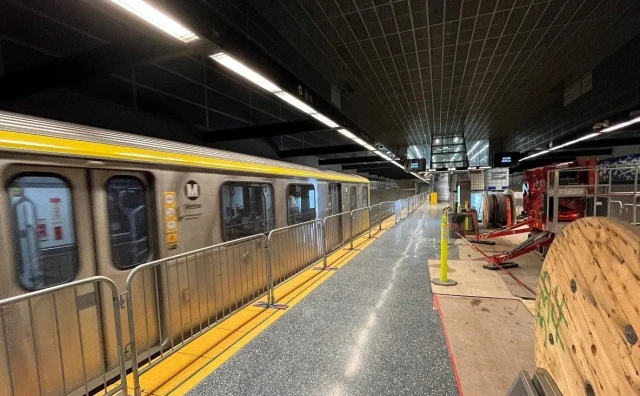With our free press under threat and federal funding for public media gone, your support matters more than ever. Help keep the LAist newsroom strong, become a monthly member or increase your support today during our fall member drive.
This archival content was written, edited, and published prior to LAist's acquisition by its current owner, Southern California Public Radio ("SCPR"). Content, such as language choice and subject matter, in archival articles therefore may not align with SCPR's current editorial standards. To learn more about those standards and why we make this distinction, please click here.
Neighborhood Project: Country Club Park

Sometimes the news really does paint our wonderful town as something of a racial powder keg, which makes it all the more gratifying when you stumble across a truly diverse neighborhood. Hugging the western border of Koreatown, just south of tony Hancock Park and just north of West Adams, sits a neighborhood where true diversity is a reality. Just how diverse is Country Club Park? Ask yourself this; where else in town can you find a vegetarian soul food restaurant steps from a Goth club, across the street from a Korean church, next door to a Mexican market, up the block from a Korean BBQ, next door to a sushi place? It’s no wonder the LA Legal Defense Fund calls this neighborhood home. Every group in the city seems to be represented. And though the tenuous presence of gangs and pockets of poverty cause hiccups, homesteaders of all backgrounds seem eager to discover this unusual urban enclave.
(Your tour of Country Club Park begins after the jump)

Boundaries: Wilshire Boulevard to the north, Pico Boulevard to the south, Wilton Place to the east and roughly La Brea Avenue to the west. The eastern and western borders are a bit blurry, and some would consider the blocks just east of Crenshaw to be part of Koreatown. Considering the abundance of Korean restaurants and small businesses lining the main thoroughfares east of that street, it's a reasonable mistake to make.
Political breakdown: Council District 10, Councilmember Herb J. Wesson, Jr.
2nd County Supervisorial District, Councilwoman Yvonne Braithwaite Burke
State Senate District 26, Representative Kevin Murray
State Assembly District 47, Representative Karen Bass
U.S. Congressional District 33, Representative Diane E. Watson

Public transit: While the northeast section of the neighborhood has easy access to the Wilshire/Western red line subway station in the heart of K-town, most of Country Club Park is well serviced by bus, with regular and rapid lines running along the major thoroughfares of Wilshire, Pico, Crenshaw and La Brea.
Crenshaw bisects the neighborhood, and both the 210 and 710 rapid service on the street are frequent. Both buses pass through Hancock Park en route to Hollywood. Going south, they head into Baldwin Hills, the Crenshaw District and Leimert Park.
The neighborhood is also home to the Pico-Rimpau Transit Center, the terminus for more than half a dozen bus lines, including several of the Santa Monica Blue Buses. Because the Blue Bus, considered a westside transit option, terminates here, the Transit Center has also come to symbolize a kind of dividing line between the wealthier and poorer sections of the neighborhood.
Recent attempts to spiff up the transit center by adding a Wells Fargo Bank and several retail options (including a Magic Johnson Starbucks and a Coldstone Creamery) have been met with a combination of cheers and jeers, as some community members cheer the arrival of the first major chains in years while others decry the molasses-slow speed of other nearby developments.
Usually considered: Midtown, Koreatown
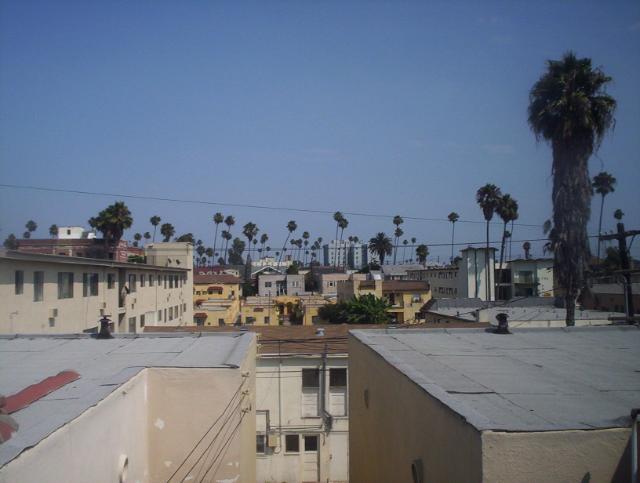
Insight: Many people don’t know where Country Club Park is, because it is a buffer community that has been somewhat annexed by its much more recognizable neighbors, Koreatown to the east, West Adams and Crenshaw to the south and Hancock Park to the north. In reality, the tiny community has inherited many of the benefits (and some of the problems) of all its neighbors. Thanks to a very active and promotion-saavy neighborhood association, it is also currently an intriguing location for many prospective urban home buyers.
And many of these homes are far from shoddy. In fact, Country Club Park has long been a hot spot for Hollywood film crews looking for exterior and interior home shots. According to a 2006 real estate feature in the Los Angeles Times, major films with segments shot in the neighborhood have included Daddy Day Care, Ali, Running With Scissors and many others.
A prototypical Country Club Park street is about 30% Korean and 40% Latino with the remainder of the residents being composed of either working-class blacks, middle-class whites or hipsters, depending on the block. The prominent plant life would be the towering Mexican Fan Palm trees (Washingtonia robusta) that line most streets.


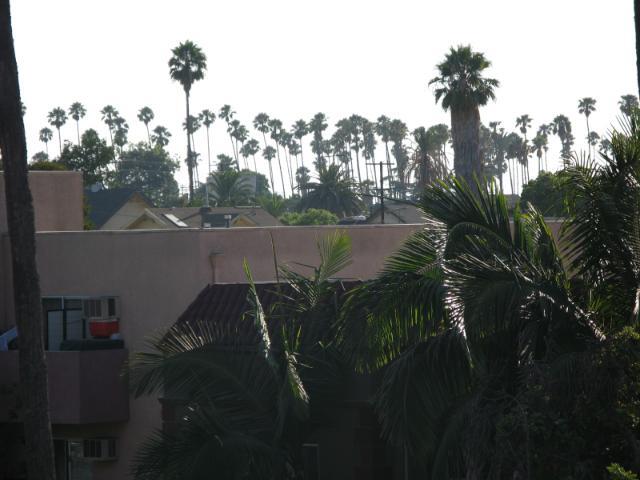
History: Visitors to Country Club Park might find themselves wondering, "exactly where is the country club?" As it turns out, there hasn't been a country club in the neighborhood in more than 100 years.
According to the LA Conservancy, from 1899 to 1905 the 250-acre Los Angeles Country Club was the primary feature of the neighborhood. The club was moved to Wilshire Bouelvard (just west of Beverly Hills), allowing Isaac Milbank's Country Club Park real estate company to subdivide the land for housing.
The brochure goes on to explain that "most of the homes in the area were built in the teens and twenties. Rows of intact and well-maintained Mediterranean “villas,” Tudor castles, Craftsman bungalows and late Victorian Queen Annes harmoniously line the streets, nurtured by the residents’ pride in and care for their neighborhood."
Most of Country Club Park was developed between 1910 and 1930. Originally segregated, it was one of the first affluent communities to allow African American residents, making it an early destination for upwardly-mobile blacks. Notable residents of the neighborhood have included Mahalia Jackson, Lou Rawls, Lena Horne, Hattie McDaniel, Tuskeegee Airman Celes King and many others.

Lay of the land: The neighborhood has plenty of apartment buildings that vary in appearance from well-maintained to badly in need of maintenance. However, the jewel of Country Club Park has to be the area around the intersection of 12th Street and Westchester Place. The network of streets surrounding the grounds of the Claretian Retreat Center contain some of the nicest homes in the neighborhood.


While some homes are modest, many of them are comparable in size and splendor to what you would see in Hancock Park.

Like this behemoth on Westchester, which I initially thought was some kind of historical society building.

I bumped into the mail carrier exiting the place and asked about it. He assured me it was a private residence owned by one person.

Neighborhood apartment buildings have their own appeal, like the fact that from top floors and rooftops one can get a wonderful view of the Hollywood Hills and the Griffith Observatory to the north.
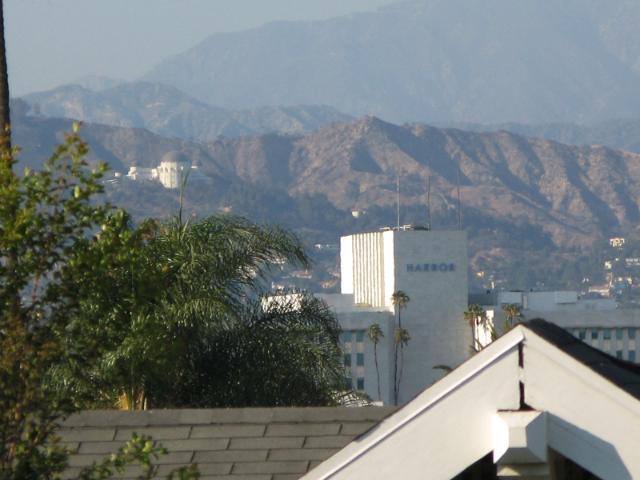
Landmarks: Though not a landmark per se, the Bekins Storage sign is one of the most immediately recognizable features of the strip along Pico Blvd.


And on Crenshaw and Country Club is the headquarters of the Legal Aid Foundation of Los Angeles.
The closest thing to a country club left in the neighborhood:
Would probably be this putting range on Bronson and Olympic, though it is rather anemic compared to some of the larger facilities scattered throughout Koreatown.
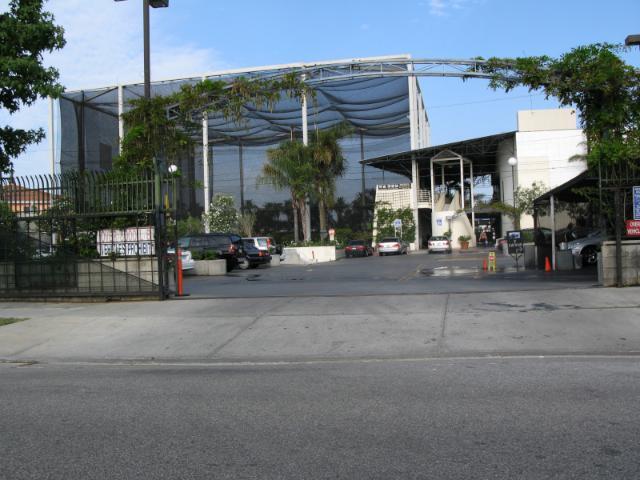

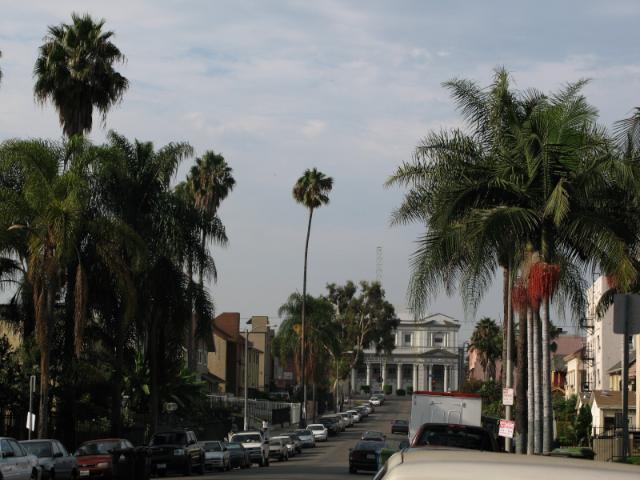
An enormous Korean church is visible at the end of this residential block.

Parks: Like far too many Los Angeles neighborhoods, Country Club Park is woefully under served by public parks. However, there are a few lovely patches of green to be found.

Including this nice little city block-sized park across the street from LA High School.


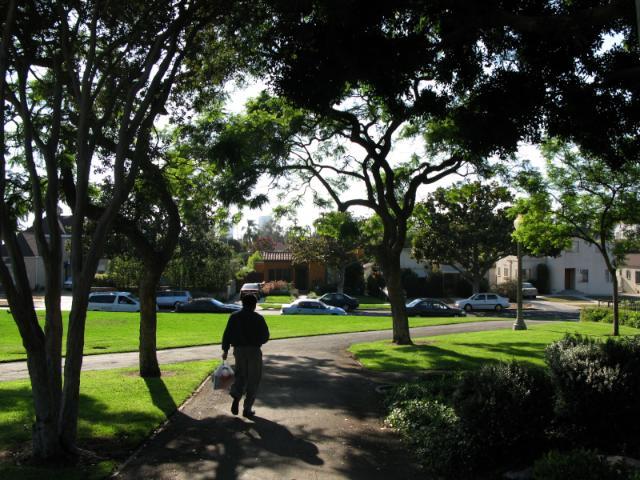
While the dominant fixture in the park during school days seems to be teenagers making out on the grass, on the weekends it is a lovely retreat for neighborhood families, with tree-lined walking paths and a well maintained playground.


The Memorial Park branch of the Los Angeles Public Library sits in the center of the park. While not the most comprehensive of branches, it occupies a lovely historic building, and the staff are among the friendlier you'll come across in the system.
Food: The food in Country Club Park mirrors the larger neighborhoods that surround it, making for an eclectic mix of ethnic eats, dominated by Korean BBQ and Salvadoran pupuserias. While by no means a destination neighborhood when it comes to dining, local residents have a fair share of tasty options at their disposal.

Probably the most well-known restaurant outside of the neighborhood is Kang Nam, a Korean-owned sushi spot that is a draw less for the food than for the cozy outdoor patio seating.


Soul Vegetarian was an awesome new addition to the neighborhood when it opened last year, featuring meat-free versions of soul food classics. Alas, sometime between when this photo was taken (Thanksgiving) and now, they closed their doors.

Quietly, Tawada sushi, across the street from a pawn shop and opposite the Pico-Rimpau Transit Center, has some surprisingly good cheap sushi. And it's even owned and operated by Japanese! The owner once ran a sushi restaurant in Chile, so his knowledge of Spanish transferred well to opening a business in this pocket of the neighborhood. His entire staff of Japanese cooks work wonders with their rolls.
The best aquarium in town?: If there is one true retail destination in the neighborhood, it is probably Fumi's Aquarium, which holds one of the best selections of freshwater and tropical fish in the city.


The large tanks always seem to have some hard to find saltwater species, like this nurse shark.

And the back room holds Fumi's wide selection of koi.






This turkey was in the aquarium's bird room, standing there next to the parakeets. I took this photo back in November. When I asked the clerk what a turkey was doing in the bird room, he said "It's not for sale. We're just letting it hang out in there. It's Thanksgiving dinner." I have no idea whether or not he was joking, but the turkey was gone when I returned in December.
A word about taggers: The proprietor of this church should receive an award from the city for perservering under extreme pressure. Country Club Park has seen an abundance of taggers spraying gang graffiti on any flat surface they can. This small church gets tagged every single week, at which point the proprietor goes out with a can of paint and diligently paints over it.

He's painted over the graf so much that the building now has a distinctly two-tone paint scheme. Country Club Park residents are unusually diligent in removing gang graffiti, which makes it very disheartening that taggers have taken to spraying their messages on most of the neighborhood's palm trees.

Just up the block from where the graf wars are being waged sits Jewel's Catch One Nightclub, an off-the-beaten-path dancing spot that draws a wide range of clientele, from gays to goths, depending on the night of the week.
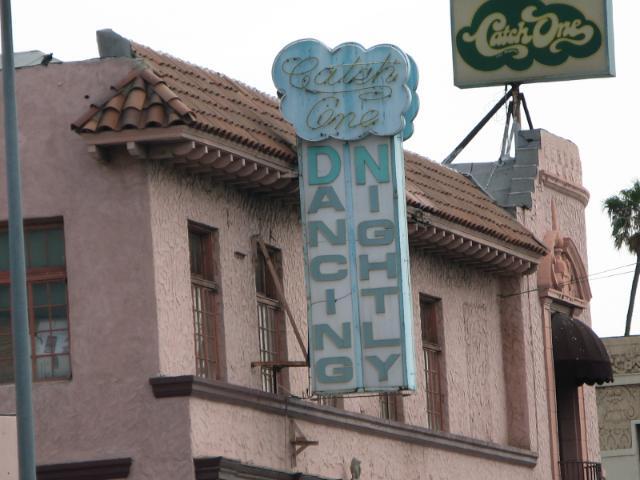
When the community comes together: Once a year in August, the residents of Country Club Park gather on the for Saturday in the Park, the annual street fair/block party held on the grounds of the Claretian Retreat Center and the surrounding streets.


Area restaurants, including Pho 36 and Chosun Galbee, have stalls serving the usual K-town delicacies.

Bulgogi, anyone?

Other entertainment includes live music, a climbing wall and appearances by the fire department and other local services. Just a good, old-fashioned block party, and a great way to get acquainted with this most real of Los Angeles neighborhoods.


Anyway, I'd better go now, before my son breaks his neck.
All photos by Kemp Powers
At LAist, we believe in journalism without censorship and the right of a free press to speak truth to those in power. Our hard-hitting watchdog reporting on local government, climate, and the ongoing housing and homelessness crisis is trustworthy, independent and freely accessible to everyone thanks to the support of readers like you.
But the game has changed: Congress voted to eliminate funding for public media across the country. Here at LAist that means a loss of $1.7 million in our budget every year. We want to assure you that despite growing threats to free press and free speech, LAist will remain a voice you know and trust. Speaking frankly, the amount of reader support we receive will help determine how strong of a newsroom we are going forward to cover the important news in our community.
We’re asking you to stand up for independent reporting that will not be silenced. With more individuals like you supporting this public service, we can continue to provide essential coverage for Southern Californians that you can’t find anywhere else. Become a monthly member today to help sustain this mission.
Thank you for your generous support and belief in the value of independent news.

-
Restaurants share resources in the food hall in West Adams as Los Angeles reckons with increasing restaurant closures.
-
It will be the second national day of protest against President Donald Trump.
-
The university says the compact, as the Trump administration called it, could undermine free inquiry and academic excellence.
-
This is the one time you can do this legally!
-
Metro officials said it will be able to announce an opening date “soon.”
-
While working for the county, the DA’s office alleges that 13 employees fraudulently filed for unemployment, claiming to earn less than $600 a week.






